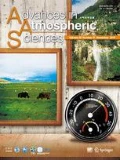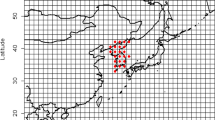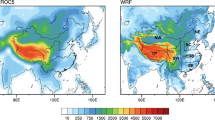Abstract
This is the second part of the authors’ analysis on the output of 24 coupled climate models from the Twentieth-Century Climate in Coupled Models (20C3M) experiment and 1% per year CO2 increase experiment (to doubling) (1pctto2x) of phase 3 of the Coupled Model Inter-comparison Project (CMIP3). The study focuses on the potential changes of July–August temperature extremes over China. The pattern correlation coefficients of the simulated temperature with the observations are 0.6–0.9, which are higher than the results for precipitation. However, most models have cold bias compared to observation, with a larger cold bias over western China (>5°C) than over eastern China (<2°C). The multi-model ensemble (MME) exhibits a significant increase of temperature under the 1pctto2x scenario. The amplitude of the MME warming shows a northwest-southeast decreasing gradient. The warming spread among the models (∼1°C-2°C) is less than MME warming (∼2°C–4°C), indicating a relatively robust temperature change under CO2 doubling. Further analysis of Geophysical Fluid Dynamics Laboratory coupled climate model version 2.1 (GFDL-CM2.1) simulations suggests that the warming pattern may be related to heat transport by summer monsoons. The contrast of cloud effects also has contributions. The different vertical structures of warming over northwestern China and southeastern China may be attributed to the different natures of vertical circulations. The deep, moist convection over southeastern China is an effective mechanism for “transporting” the warming upward, leading to more upper-level warming. In northwestern China, the warming is more surface-orientated, possibly due to the shallow, dry convection.
Similar content being viewed by others
References
Alexander, L., and Coauthors, 2006: Global observed changes in daily climate extremes of temperature and precipitation. J. Geophys. Res., 111, 1–22.
Christensen, J. H., and Coauthors, 2007: Regional climate projections. Climate Change 2007: The physical science basis. Contribution of Working Group I to the Fourth Assessment Report of the Intergovernmental Panel on Climate Change, Solomon et al., Eds., Cambridge University Press, 879–886.
Cai, M., and J. Lu, 2007: Dynamical greenhouse-plus feedback and polar warming amplification. Part II: Meridional and vertical asymmetries of the global warming. Climate Dyn., 29, 375–391, doi: 10.1007/s00382-007-0238-9.
Chen, H., T. Zhou, R. B. Neale, X. Wu, and G. J. Zhang, 2010: Performance of the new NCAR CAM3.5 in East Asian summer monsoon simulations: Sensitivity to modifications of the convection scheme. J. Climate, 23, 3657–3675.
Duan, A., and G. Wu, 2006: Change of cloud amount and the climate warming on the Tibetan Plateau. Geophys. Res. Lett., 33, L22704, doi: 10.1029/2006GL027946.
Frich, P., L. V. Alexander, P. Della-Marta, B. Gleason, M. Haylock, A. M. G. K. Tank, and T. Peterson, 2002: Observed coherent changes in climatic extremes during the second half of the twentieth century. Climate Research, 19, 193–212.
Gao, X., Z. Zhao, Y. Ding, R. Huang, and F. Giorgi, 2001: Climate change due to greenhouse effects in China as simulated by a regional climate model. Adv. Atmos. Sci., 18, 1225–1230.
Gao, X., Z. Zhao, and F. Giorgi, 2002: Changes of extreme events in regional climate simulations over East Asia. Adv. Atmos. Sci., 19, 927–942.
Gao, X., D. Li, Z. Zhao, and F. Giorgi, 2003: Climate change due to greenhouse effects in Qinghai-Xizang Plateau and along the Qianghai-Tibet Railway. Plateau Meteorology, 22, 458–463. (in Chinese)
Giorgi, F., J. W. Hurrell, M. R. Marinucci, and M. Beniston, 1997: Elevation signal in surface climate change: A model study. J. Climate, 10, 288–296.
Huang, D., Y. Qian, and J. Zhu, 2010: Trends of temperature extremes in China and their relationship with global temperature anomalies. Adv. Atmos. Sci., 27(4), 937–946, doi: 10.1007/s00376-009-9085-4.
Hassol, S., 2004: Impacts of a Warming Arctic: Arctic Climate Impact Assessment. Cambridge University Press, Cambridge, 146pp.
Karl, T., and Coauthors, 1993: Asymmetric trends of daily maximum and minimum temperature. Bull. Amer. Meteor. Soc., 74(6), 1007–1023.
Kharin, V. V., F. W. Zwiers, X. Zhang, and G. C. Hegerl, 2007: Changes in temperature and precipitation extremes in the IPCC ensemble of global coupled model simulations. J. Climate, 20, 1419–1444.
Li, H., 2007: Observational analysis and numerical simulation of mid-summer precipitation and temperature characteristic variations over China in the past 40 years. M. S. thesis, Institute of Atmospheric Physics, Chinese Academy of Sciences, 51–60. (in Chinese)
Li, H., T. Zhou, and R. Yu, 2008: Analysis of July–August daily precipitation characteristics variation in eastern China during 1958–2000. Chinese J. Atmos. Sci., 32(2), 358–370. (in Chinese)
Li, H., T. Zhou, and J. Nam, 2009: Comparison of daily extreme temperatures over eastern China and South Korea between 1996–2005. Adv. Atmos. Sci., 26, 253–264, doi: 10.1007/s00376-009-0253-3.
Li, H., L. Feng, and T. Zhou, 2010a: Multi-model projection of July–August climate extreme changes over China under CO2 doubling. Part I: Precipitation. Adv. Atmos. Sci., doi: 10.1007/s00376-010-0013-4.
Li, H., A. Dai, T. Zhou, and J. Lu, 2010b: Responses of East Asian summer monsoon to historical SST and atmospheric forcing during 1950–2000, Climate Dynamics, 34, 501–514, doi: 10.1007/s00382-008-0482-7.
Liu, X., Z. Yin, X. Shao, and N. Qin, 2006: Temporal trends and variability of daily maximum and minimum, extreme temperature events, and growing season length over the eastern and central Tibetan Plateau during 1961–2003, J. Geophys. Res., 111, D19109, doi: 10.1029/2005JD006915.
Lobell, D. B., C. Bonfils and P. B. Duffy, 2007: Climate change uncertainty for daily minimum and maximum temperatures: A model intercomparison. Geophys. Res. Lett., 34, 5715–5715.
Lu, J., and M. Cai, 2010: Quantifying contributions to polar warming amplification in an idealized coupled general circulation model. Climate Dyn., 34, 669–687.
Ma, X., 1999: The asymmetic change of maximum and minimum temperature in the northwest China. Acta Meteorologica Sinica, 57(5), 613–621. (in Chinese)
Meehl, G., W. M. Washington, J. M. Arblaster, T. W. Bettge, and W. G. Strand Jr., 2000: Anthropogenic forcing and decadal climate variability in sensitivity experiments of twentieth- and twenty-first century climate. J Climate, 13, 3728–3744.
Meehl, G., J. Arblaster, and C. Tebaldi, 2005: Understanding future patterns of increased precipitation intensity in climate model simulations. Geophys. Res. Lett., 32, doi: 10.1029/2005GL023680.
Randall, D. A., and Coauthors, 2007: Cilmate models and their evaluation. Climate Change 2007: The Physical Science Basis. Contribution of Working Group I to the Fourth Assessment Report of the Intergovernmental Panel on Climate Change, Solomon et al., Eds., Cambridge University Press, 591–648.
Trenberth, K., and Coauthors, 2007: Observations: Surface and atmospheric climate change. Climate Change 2007: The Physical Science Basis, Solomon et al., Eds., Cambridge University Press, Cambridge, 235–336.
Tebaldi, C., K. Hayhoe, J. M. Arblaster, and G. A. Meehl, 2006: Going to the extremes: An intercomparison of model-simulated historical and future changes in extreme events. Climatic Change, 79, 185–211.
Turner, A., and J. Slingo, 2009: Uncertainties in future projections of extreme precipitation in the Indian monsoon region. Atmos. Sci. Letts., 10(3), 152–158.
Weisheimer, A., and T. N. Palmer, 2005: Changing frequency of occurrence of extreme seasonal temperatures under global warming. Geophys. Res. Lett., 32, 1–5.
Xu, Y., C. Xu, X. Gao, and Y. Luo, 2009: Projected changes in temperature and precipitation extremes over the Yangtze River basin of China in the 21st century. Quaternary International, 208, 44–52.
Xu, Y. L., Y. Zhang, E. D. Lin, W. T. Lin, W. J. Dong, R. Jones, D. Hassell, and S. Wilson, 2006: Analyses on the climate change responses over China under SRES B2 scenario using PRECIS. Chinese Science Bulletin, 51, 2260–2267. (in Chinese)
Zhai, P., and X. Pan, 2003: Trends in temperature extremes during 1951–1999 in China. Geophys. Res. Lett., 30, doi: 10.1029/2003GL018004.
Zhai, P., X. Zhang, H. Wan, and X. Pan, 2005: Trends in total precipitation and frequency of daily precipitation extremes over China. J. Climate, 18, 1096–1108.
Zhang, Y., Y. Xu, W. Dong, L. Cao, and M. Sparrow, 2006: A future climate scenario of regional changes in extreme climate events over China using the PRECIS climate model. Geophys. Res. Lett., 33, 1–6.
Zhou, T., and Z. Li, 2002: Simulation of the east Asian summer monsoon by using a variable resolution atmospheric GCM. Climate Dyn., 19, 167–180.
Zhou, T., and R. Yu, 2006: Twentieth century surface air temperature over China and the globe simulated by coupled climate models. J. Climate, 19, 5843–5858.
Zhou, T., Y. Yu, H. Liu, W. Li, X. You, and G. Zhou, 2007: Progress in the development and application of climate ocean models and ocean-atmosphere coupled models in China. Adv. Atmos. Sci., 24, 729–738, doi: 10.1007/s00376-007-1109-3.
Zhou, T., B. Wu, and B. Wang, 2009a: How well do atmospheric general circulation models capture the leading modes of the interannual variability of Asian-Australian monsoon? J. Climate, 22, 1159–1173.
Zhou, T., and Coauthors, 2009b: The CLIVAR C20C Project: Which components of the Asian-Australian monsoon circulation variations are forced and reproducible? Climate Dyn., 33, 1051–1068.
Author information
Authors and Affiliations
Corresponding author
Rights and permissions
About this article
Cite this article
Li, H., Feng, L. & Zhou, T. Multi-model projection of July–August climate extreme changes over China under CO2 doubling. Part II: Temperature. Adv. Atmos. Sci. 28, 448–463 (2011). https://doi.org/10.1007/s00376-010-0052-x
Received:
Revised:
Published:
Issue Date:
DOI: https://doi.org/10.1007/s00376-010-0052-x




